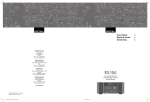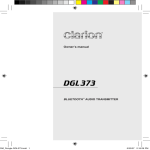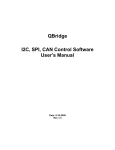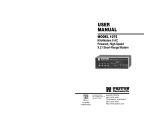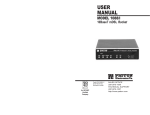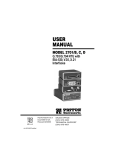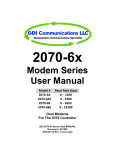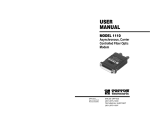Download Patton electronic Model 1065 User's Manual
Transcript
USER MANUAL MODEL 1065 Industrial Synchronous & Asynchronous Short Range Modem Part# 07M1065-A Doc# 058041UA Revised 08/11/99 An ISO-9001 Certified Company SALES OFFICE (301) 975-1000 TECHNICAL SUPPORT (301) 975-1007 http://www.patton.com 1.0 WARRANTY INFORMATION 1.2 SERVICE Patton Electronics warrants all Model 1065 components to be free from defects, and will—at our option—repair or replace the product should it fail within one year from the first date of shipment. This warranty is limited to defects in workmanship or materials, and does not cover customer damage, abuse or unauthorized modification. If this product fails or does not perform as warranted, your sole recourse shall be repair or replacement as described above. Under no condition shall Patton Electronics be liable for any damages incurred by the use of this product. These damages include, but are not limited to, the following: lost profits, lost savings and incidental or consequential damages arising from the use of or inability to use this product. Patton Electronics specifically disclaims all other warranties, expressed or implied, and the installation or use of this product shall be deemed an acceptance of these terms by the user. 1.1 RADIO AND TV INTERFERENCE The Model 1065 generates and uses radio frequency energy, and if not installed and used properly—that is, in strict accordance with the manufacturer's instructions—may cause interference to radio and television reception. If the Model 1065 does cause interference to radio or television reception, which can be determined by disconnecting the RS-232 interface, the user is encouraged to try to correct the interference by one or more of the following measures: moving the computing equipment away from the receiver, re-orienting the receiving antenna and/or plugging the receiving equipment into a different AC outlet (such that the computing equipment and receiver are on different branches). 1 All warranty and non-warranty repairs must be returned freight prepaid and insured to Patton Electronics. All returns must have a Return Materials Authorization number on the outside of the shipping container. This number may be obtained from Patton Electronics Technical Service at: tel: (301) 975-1007; email: [email protected]; or, www: http://www.patton.com. NOTE: Packages received without an RMA number will not be accepted. Patton Electronics' technical staff is also available to answer any questions that might arise concerning the installation or use of your Model 1065. Technical Service hours: 8AM to 5PM EST, Monday through Friday. 2 2.0 GENERAL INFORMATION 3.0 CONFIGURATION OVERVIEW Thank you for your purchase of this Patton Electronics product. This product has been thoroughly inspected by Patton's qualified technicians. If any questions or problems arise during installation or use of this product, please do not hesitate to contact Patton Electronics Technical Support at (301) 975-1007. The Model 1065 is fairly simple to install and is ruggedly designed for excellent reliability: just set it and forget it. The following instructions will help you set up and install the Model 1065 properly. 2.1 FEATURES The Model 1065 uses 24 external mini DIP switches that allow configuration to an extremely wide range of applications. These 24 DIP switches are grouped into three eight-switch sets, and are externally accessible from the underside of the unit (see Figure 1). Since all configuration DIP switches are externally accessible, there is no need to open the case for configuration. • • • • • • • • • • • • Synchronous or asynchronous operation Model 1065 supports data rates up to 64.0 kbps Two-wire/half duplex or four-wire/full or half duplex V.52 & V.54 test modes Equalization Anti-streaming timer Distances up to 12 miles (19.2 km) Point-to-point or multipoint Internal, external or received loopback clocking 2000 VAC transformer isolation & high speed surge protection Internal power supply Mono-color LED indicators 3.1 CONFIGURATION SWITCHES The configuration switches allow you to select data rates, clocking methods, V.52 & V.54 tests, word lengths, extended signaling rates, async. or sync. mode, 2- or 4-wire operation, anti-stream control and input impedance. The drawings, text and tables on the following pages describe all switch locations, positions and functions. 2.2 DESCRIPTION The Model 1065 Industrial Short Range Modem operates 2-wire (half duplex) or 4-wire (full or half duplex), in synchronous or asynchronous modes, over unconditioned telephone lines. The Model 1065 supports bit rates up to 64.0 kbps. The Model 1065 operates in synchronous mode between the local and remote modems; when connected to an asynchronous RS-232 device, the Model 1065 SRM converts the asynchronous data to synchronous data. S3 S2 S1 ON OFF The Model 1065 has several features to enhance overall performance: equalization, anti-streaming timer, transformer isolation to guard against data loss due to ground potential differences, and Silicon Avalanche Diode surge protection to guard against data line transients. The Model 1065 features V.52 compliant bit error rate pattern tests and two V.54 test modes: local analog loopback and remote digital loopback. The operator at the local end may test both local and remote modems, plus the line, in the digital loopback mode. Both RDL and LAL modes can be controlled by a manual switch or via the V.24/RS-232 interface. 3 REAR FRONT Figure 1. Bottom view of Model 1065 Series, showing location of DIP switches 4 The Model 1065 SRM has three sets of eight switches, yielding 24 total DIP switches. The three sets will be referred to as S1, S2 and S3. As Figure 2 shows, the orientation of all DIP switches is the same with respect to “ON” and “OFF” positions. Shown in the tables below are DIP Switch settings for Models 1065. MODEL 1065 DATA RATE SETTINGS S1-1 On Off On Off On Off On Off Off On Off Off On Off Off ON OFF Figure 2. Close-up of DIP switches showing “ON” and “OFF” positions 3.2 CONFIGURATION SWITCH SET “S1” The DIP switches on S1 set data rate, clock source, async./sync. mode and carrier control method. The default settings are summarized in the table below. MODEL 1065 S1 SUMMARY TABLE Position Function Factory Default S1-1 Data Rate On S1-2 Data Rate Off S1-3 Data Rate Off S1-4 Data Rate On S1-5 Clock Source On S1-6 Clock Source On } * S1-2 On On Off Off On On Off Off On On On Off On On On S1-3 On On On On Off Off Off Off Off On On Off Off Off On S1-4 On On On On On On On On On Off Off On Off Off Off S3-3 Setting Off 1.2 kbps Off 1.8 kbps Off 2.4 kbps Off 3.6 kbps Off 4.8 kbps Off 7.2 kbps Off 9.6 kbps Off 14.4 kbps On 16.0 kbps Off 19.2 kbps Off 28.8 kbps On 32.0 kbps Off 38.4 kbps Off 57.6 kbps On 64.0 kbps Must have switch 3-3 On Switches S1-5 and S1-6: Clock Source 9,600 bps } Internal S1-7 Async./Sync. On Async. S1-8 Carrier Control Off Constantly On Switches S1-5 and S1-6 are set in combination to determine the transmit clock source for the Model 1065 Series. S1-5 On Off On S1-6 On On Off Setting Internal transmit clock Receive recover clock External transmit clock Switch S1-7: Asynchronous/Synchronous Mode Switches S1-1 through S1-4 & S3-3: Data Rate Setting Switches S1-1, S1-4, and S3-3 are set in combination to determine the asynchronous and synchronous data rate for the Model 1065. 5 The setting for switch S1-7 determines whether the Model 1065 Series is in asynchronous or synchronous operating mode. S1-7 On Off Setting Asynchronous Synchronous 6 * * * Switch S1-8: Carrier Control Method Switch S2-3: Extended Signaling Rate The setting for switch S1-8 determines whether the carrier is “constantly on” or “controlled by RTS”. This setting allows for operation in switched carrier, multipoint and/or hardware handshaking applications. The setting for switch S2-3 determines the range of variability the Model 1065 Series “looks for” in asynchronous data rates (i.e., the actual variance from a given frequency level the Model 1065 Series will tolerate). Setting Constantly on Controlled by RTS S1-8 Off On S2-3 Off On Setting -2.5% to +1% -2.5% to +2.3% 3.3 CONFIGURATION SWITCH SET “S2” The DIP switches on S2 set word length, extended signaling rate, RTS/CTS delay, V.52 and V.54 diagnostic test and 2- and 4-wire operation. S2 SUMMARY TABLE Position Function S2-1 Word Length Factory Default Off S2-2 Word Length Off } 10 bits S2-3 Extended Signaling Rate S2-4 RTS/CTS Delay Off -2.5% to 1% On S2-5 RTS/CTS Delay On S2-6 2-Wire/4-Wire S2-7 2-Wire/4-Wire Off (4-Wire) FDX S2-8 V.54 Off V.54 Enabled } On (4-Wire) FDX Switches S2-1 and S2-2 are set in combination to determine the word length for asynchronous data, including the start and stop bits. S2-2 On On Off Off Setting 8 bits 9 bits 10 bits 11 bits 7 The combined settings for switches S2-4 and S2-5 determine the amount of delay between the time the unit “sees” RTS and when it sends CTS. Options are no delay, 7 ms and 53 ms. S2-4 On Off On Off S2-5 On On Off Off Setting 7 ms 53 ms No delay No delay 7 ms Switches S2-1 and S2-2: Word Length S2-1 Off On Off On Switches S2-4 and S2-5: RTS/CTS Delay Switch S2-6 & S2-7: 2-Wire/4-Wire Mode Selection The setting for switch S2-6 and S2-7 determines whether the Model 1065 Series is operating in 2-wire or 4-wire mode. S2-6 On On Off S2-7 On Off On Setting 4-wire (half duplex) 4-wire (full duplex) 2-wire (half duplex) Switch S2-8: V.54 Loopback Test Enable This switch enables or disables V.54 looping in the Model 1065. S2-8 Off On Setting V.54 Normal Operation Enabled V.54 Testing Disabled 8 S3-1, S3-2 SELECTION TABLE FOR MODEL 1065 3.4 CONFIGURATION SWITCH SET “S3” The DIP switches on S3 set the anti-stream control, local loopback enable, remote loopback enable and receive (input) impedance levels for the Model 1065. Factory default positions of Switch S3 are shown in the table below. S3 SUMMARY TABLE Position Function S3-1 Input Impedance On S3-2 Input Impedance Off S3-3 S3-4 Timing Mode Topology Factory Default } 200 Ohms Gauge of Data Rates, kb/s Cable 1.2 1.8 2.4 3.6 4.8 7.2 9.6 14.4 19.2 28.8 38.4 57.6 19AWG/.9mm 320 320 200 200 200 200 200 130 130 130 130 High 22AWG/.6mm 320 320 320 200 200 200 200 200 130 130 130 High 24AWG/.5mm 320 320 320 320 200 200 200 200 200 130 130 High 26AWG/.4mm 320 320 320 320 320 200 200 200 200 200 130 High S3-1, S3-2 SELECTION TABLE FOR MODEL 1065 (CONTINUED) Off Gauge of On Point to Point Cable Data Rates, kb/s 16 32 64 S3-5 Local Loopback Off Disabled 19AWG/.9mm 130 130 High S3-6 Remote Loopback Off Disabled 22AWG/.6mm 200 130 High S3-7 Anti-stream Control Off 24AWG/.5mm 200 130 High S3-8 Anti-stream Control Off 26AWG/.4mm 200 Switch S3-3: Rate Selection 200 High } Disabled Switches S3-1 & S3-2: Input Impedance The setting for Switches S3-1 and S3-2 determines the 1065 Series’ input impedance. This allows you to choose the optimum impedance setting for your application. In long distance applications the impedance of the cable must match the impedance of the load (or resistor) of the Model 1065 Series unit. Thicker gauge cables requires a lower Ohm setting, while a thinner gauge cable should receive a higher Ohm setting. If you are using higher speeds you will need a lower Ohm setting, and a higher Ohm setting for the slower speeds. Refer to the table on the following page for assistance in selecting a setting. S3-1 On On Off Off S3-2 On Off On Off Setting 130 Ohms 200 Ohms 320 Ohms High impedance (minimum 2k ohms) 9 Use Switch S3-3 to select the timing mode of the 1065. To operate the 1065 at 16, 32, or 64kbps, set S3-3 to the On position. To select any other DTE rate, set Switch S3-3 Off. S3-3 On Off Setting 16, 32, or 64kbps 1.2 - 57kbps, excluding 16 kbps and 32kbps Switch S3-4: Topology Use switch S3-4 to select the topology of the Model 1065. S3-4 On On Off Setting Point to point Master multi-point Slave multi-point 10 Switch S3-5: RS-232 Initiation of Local Loopback Test The setting for switch S3-5 determines whether or not the Model 1065 local analog loopback test can be initiated by raising pin 18 on the RS-232 interface. S3-5 On Off Setting RS-232 initiation enabled RS-232 initiation disabled Switch S3-6: RS-232 Initiation of Remote Loopback Test The setting for switch S3-6 determines whether or not the Model 1065 remote digital loopback test can be initiated by raising pin 21 on the RS-232 interface. S3-6 On Off 4.0 INSTALLATION The Model 1065 operates in four twisted pair topologies: 2-wire/point-to-point, 2-wire/multipoint, 4-wire/point-to-point, and 4-wire/multipoint. In each of these topologies, the twisted pair wire must be 19 - 26 AWG "dry", unconditioned metallic wire (see Appendix C for wire recommendations). Dial-up analog circuits, such as those used with a standard Hayes-type modem, are not acceptable. The twisted pair may be shielded or unshielded. Both types yield favorable results. The Model 1065 offers an RJ-45 jack for its twisted pair line connection. Figure 4 (below) shows the location of these interfaces on the rear panel of the Model 1065 Series. Connect the wire to each Model 1065 Series as described in the instructions that follow the illustration. The “+” and “-” indicators are for reference only. Setting RS-232 initiation enabled RS-232 initiation disabled Switches S3-7 and S3-8: Anti-stream Control Switches S3-7 and S3-8 are set in combination to determine the time out period for the Model 1065 Series’ anti-stream control timer. S3-7 Off Off On On S3-8 Off On Off On Setting Disabled 12.5 seconds 50.0 seconds 12.5 seconds Figure 4. Model 1065 rear panel. 4.1 TWO-WIRE INSTALLATION When communicating over a single twisted pair circuit, the Model 1065 operates half duplex: that is, it transmits in only one direction at a time. This method of operation is effective for both point-to-point and multipoint applications. In single pair point-to-point applications, you will need a pair of Model 1065s for each circuit—one at each end of the single pair wire. In single-pair multipoint applications you will need three or more Model 1065 units. These can be connected using a star topology, although a daisy chain topology is usually used. 11 12 4.2 FOUR-WIRE INSTALLATION 4.1.1 Two-Wire Cable Connection Via RJ-45 A. The RJ-45 jack on a Model 1065 Series Short Range Modem is prewired for a standard TELCO wiring environment. To be sure you have the right wiring, use the table below as a guide. RJ-45 1 2 3 4 5 6 7 8 SIGNAL -------------NC -------------GND† -------------RCV -------------XMT -------------XMT -------------RCV -------------GND -------------NC When communicating over a two twisted pair circuit, the Model 1065 can operate full or half duplex, point-to-point or multipoint. In two pair point-to-point applications, you will need a pair of Model 1065s for each circuit—one at each end of the two pair cable. In two pair multipoint applications you will need three or more Model 1065 units. These can be connected using a star topology, although a daisy chain topology is usually used. 4.2.1 Four-Wire Cable Connection Via RJ-45 A. The RJ-45 jack on a Model 1065 Short Range Modem is prewired for a standard TELCO wiring environment. To be sure you have the right wiring, use the table below as a guide. RJ-45 † SIGNAL Connection to ground is optional 1 2 3 4 5 6 7 8 B. Proper wiring of pairs between the two modems is as follows: SIGNAL PIN# COLOR* XMT XMT 4 5 Green ------------Green Red ---------------Red COLOR PIN# 4 5 SIGNAL XMT XMT -------------NC -------------GND† -------------RCV -------------XMT -------------XMT -------------RCV -------------GND -------------NC *Standard color codes—yours may be different C. AT&T standard modular color codes: B. Proper crossing of pairs between the two modems is as follows: † 1 2 3 4 5 6 7 8 - Blue Orange Black Red Green Yellow Brown Slate Connection to ground is optional SIGNAL PIN# COLOR* COLOR PIN# GND† RCV XMT XMT RCV GND 2 3 4 5 6 7 Orange ----------Brown Black -------------Green Red ---------------Yellow Green ------------Black Yellow ------------Red Brown ------------Orange *Standard color codes—yours may be different † Connection to ground is optional 13 14 7 5 6 3 4 2 SIGNAL GND XMT RCV RCV XMT GND C. AT&T standard modular color codes: 4.3.1 Multipoint Twisted Pair Connection 1 2 3 4 5 6 7 8 - Blue Orange Black Red Green Yellow Brown Slate The Model 1065 supports multipoint applications using a star topology. Maximum distance between the units will vary based upon the number of drops, data rate, wire gauge, etc. Call Patton Technical Support for specific distance estimates. Figures 5 and 6 show how to wire the one-pair and two-pair cables properly for a Model star topology. Note that the ground connection is not needed. 4.3 FOUR-WIRE, MULTIPOINT INSTALLATION Multipoint operation involves the connection of several terminals to one host port. In such an application, one local Model 1065 is used as a master unit, and it is connected to several remote Model 1065s that are acting as slaves. HOST FIRST SLAVE SECOND SLAVE In a multipoint environment the master Model 1065 transmits continually. Initiation of two-way communication is RTS controlled by each “slave” Model 1065 unit. To facilitate multipoint communication, the master Model 1065 should have its carrier control DIP switch set to “constantly ON” (S1-8=OFF). Each slave Model 1065 unit should have its carrier control DIP switch set to “controlled by RTS” (S1-8=ON). Figure 5 illustrates a typical Model 1065 multipoint application. XMT-----------------------------RCV ------------------------------------------------------------------RCV XMT-----------------------------RCV ------------------------------------------------------------------RCV RCV-----------------------------XMT ------------------------------------------------------------------XMT RCV-----------------------------XMT ------------------------------------------------------------------XMT HOST FIRST SLAVE SECOND SLAVE XMT-----------------------------XMT ------------------------------------------------------------------XMT RCV-----------------------------XMT ------------------------------------------------------------------XMT 4.4 RS-232 CONNECTION Figure 5. Typical multipoint set-up 15 Connect the synchronous or asynchronous output of your RS-232 device to the DB-25 interface on the rear panel of the Model 1065. Note: The Model 1065 is wired to connect to a DTE. If your RS-232 output device is DCE, call Patton Technical Support at: (301) 9751007; http://www.patton.com; or, [email protected] for specific installation instructions. 16 5.0 OPERATION Once you have configured each Model 1065 Series unit properly and connected the twisted pair and RS-232 cables (see Section 4.0), you are ready to operate the units. This section describes reading the LED status monitors, powering-up and using the built-in V.52 and V.54 test modes. 5.1 LED STATUS MONITORS The Model 1065 Series features seven front panel status LEDs that indicate the condition of the modem and communication link. Figure 5 shows the front panel location of each LED. Following Figure 6 is a description of each LED's function. Model 1065 Industrial Short Range Modem Power TX RX RTS CD Error Test V.54 Test Modes 511 511E - - Remote - Normal - Local Figure 6. Model 1065 front panel. 5.1.1 The “TD” and “RD” Indicators 5.1.4 The “Error” Indicators The “Error” indicator LED has two functions: A. When the 1065 unit is in test mode (green “Test” LED is lit), the error LED glows red when bit errors occur. B. When not in test mode (green “Test” LED is off), the error LED is used to indicate an RTS streaming condition. (See Section 5.2) for information on the anti-streaming circuitry. 5.2 ANTI-STREAMING ERROR INDICATOR When not in test mode (green “Test” LED is off), the front panel “Error” LED is used to indicate a streaming error. When the Model 1065s’ anti-streaming circuitry is enabled, the RTS signal from the DTE is timer controlled. The timer begins to count when the DTE raises RTS. If the time period that RTS remains high exceeds the preset time out period, the anti-stream circuit will force RTS low. The “Error” LED will light red, indicating a streaming condition (RTS continually on). This feature prevents a malfunctioning terminal from tying-up a computer port in a multi-drop or polling environment. When the DTE drops RTS, the anti-streaming timer is automatically reset and the front panel “Error” LED turns off. The time out period is DIP switch selectable for 12.5 or 50 seconds. The Power LED glows green to signal power present. The “TD” and “RD” indicators blink green with data activity. Off indicates a low RS232 logic level, green indicates a high RS-232 logic level. Note: RS232 devices idle in a low state, so the LED will be off if the connections are correct and the RS-232 device is in an idle state. 5.1.2 The “RTS” and “CD” Indicators The “RTS” and “CD” indicators are monocolor and will be off for a “low” signal or green for a “high” signal. RTS lights for an incoming signal on RS-232 pin 4. CD lights for an incoming signal on the line side, and the resulting output signal on RS-232 pin 8. 5.1.3 The “Test” Indicator The yellow“Test” LED indicates that V.52 or V.54 tests are running. 17 18 5.3 POWER-UP 5.4.2 Remote Digital Loopback (RDL) Apply AC power to the Model 1065 by plugging the separate AC power cable first into the rear panel of the Model 1065 and then into an acceptable AC power outlet. The remote/normal/loopback switch should be set to “normal”. When the local and remote Model 1065 are poweyellow up, and passing data normally, the following LED conditions will exist: The Remote Digital Loopback (RDL) test checks the performance of both the local and remote Model 1065s and the communication link between them. Any characters sent to the remote 1065 in this test mode will be returned back to the originating device. For example, characters typed on the keyboard of the local terminal will appear on the local terminal screen after having been passed to the remote Model 1065 and looped back. To perform an RDL test, follow these steps: • TD & RD = flashing on and off • RTS & DCD = green • TEST = off A. Activate RDL. This may be done in two ways: By moving the front panel toggle switch UP to "Remote" or by raising pin 21 on the RS-232 interface (Note: Make sure DIP switch S3-6 is ON; and DIP switch S2-6 is OFF). 5.4 V.54 TEST MODES The Model 1065 offers two V.54 test modes to evaluate the condition of the modems and the communication link. These tests can be activated physically from the front panel, or via the RS-232 interface. Note: V.54 test modes are available for point-to-point applications only. 5.4.1 Local Analog Loopback (LAL) The Local Analog Loopback (LAL) test checks the operation of the local Model 1065 Series unit, and is performed separately on each unit. Any data sent to the local Model 1065 in this test mode will be echoed (returned) back to the user device. For example, characters typed on the keyboard of a terminal will appear on the terminal screen. To perform a LAL test, follow these steps: A. Activate LAL. This may be done in one of two ways: By moving the front panel toggle switch DOWN to "Local" or by raising pin 18 on the RS-232 interface (Note: Make sure DIP switch S2-6 is OFF, and DIP switch S3-5 is ON). Once LAL is activated, the Model 1065s transmit output is connected to its own receiver. The "test" LED should be lit. B. Verify that the data terminal equipment is operating properly and can be used for a test. If a fault is indicated, call a technician or replace the unit. C. Perform a BER (bit error rate) or 511/511E test on each unit. If the BER test equipment indicates no faults, but the data terminal indicates a fault, follow the manufacturer's checkout procedures for the data terminal. Also, check the RS-232 interface cable between the terminal and the Model 1065. 19 B. Perform a BER (bit error rate) 511/511E test on the system. C. If the BER test equipment indicates a fault, and the Local Analog Loopback test was successful for both Model 1065 Series units, you may have a problem with the twisted pair line between the modems. You should then test the twisted pair line for proper connections and continuity. 5.4.3 Using the V.52 BER Test Independently The V.52 BER test can be used independently of the V.54 loopback tests. This requires two operators: one to initiate and monitor the test at the local Model 1065, and one at the remote Model 1065. To use the V.52 BER test by itself, both operators should simultaneously follow these steps: 1. Locate the “511/511E” toggle switch on the front panel of the unit and move it UP. This activates the V.52 BER test mode and transmits a “511” test pattern to the other unit. If any errors are present, the receiving modem's red “ERROR” LED will blink sporadically. Note: For this test to function, the “511” switch on both Model 1065 units must be on. 2. If the test indicates no errors are present, move the V.52 toggle switch DOWN, activating the “511/E” test with periodic errors present. If the test is working properly, the receiving modem’s yellow “ERROR” LED will blink regularly. A successful “511/E” test will confirm that the link is in place, and that the Model 1065s’ built-in “511” generator and detector are working properly. 20 5.5 POWER-DOWN APPENDIX A Turn off the Model 1065 Series by simply unplugging the AC power cord from the wall. There is no power switch. PATTON ELECTRONIICS MODEL 1065 SPECIFICATIONS Transmission Format: Interface: Transmission Line: Data Rates: Clocking: Controls: Applications: Indicators: RTS Anti-stream Timer Diagnostics: Transformer Isolation: Surge Protection: Temperature: Humidity: Dimensions: Power Supply: 21 Synchronous or asynchronous, 2wire/half duplex, or 4-wire/full or half duplex RS-232 (CCITT V.24) connection via DB-25 female; twisted pair connection via RJ-45 2 or 4-wire UTP, 19 - 26 AWG Model 1065 - Synchronous or asynchronous at 1.2, 1.8, 2.4, 3.6, 4.8, 7.2, 9.6, 14.4, 19.2, 28.8, 38.4, 57.6 and 64 kbps—switch selectable; Internal, external or receive recover Carrier constantly “ON” or “controlled by RTS”; RTS/CTS delay set to no delay, 7 or 53 ms Point-to-point or multi-point Mono-color LED indicators for TD, RD, RTS & DCD; single LED indicators for Power, Test, and Error 12.5 sec., 50 sec., or disabled (switch selectable); tolerance: +50%, -0 V.52 compliant bit error rate pattern (511/511E pattern) generator and detector with error injection mode; V.54 compliant—Local Analog Loopback and Remote Digital Loopback, activated by front panel switch or via RS-232 interface 2000 V RMS Immune to IEC-801-5 Level 2, 1kV -10°C to 70°C 100% condensing from -10°C to +30°C Absolute humidity from +30°C to +70°C 5.5” (W) X 7.5” (D) X 1.6” (H) (13.9 cm X 19 cm X 4 cm) 157-242 VAC Universal Interface 22 APPENDIX B APPENDIX C PATTON ELECTRONICS MODEL 1065 FACTORY REPLACEMENT PARTS AND ACCESSORIES PATTON ELECTRONICS MODEL 1065 CABLE RECOMMENDATIONS Description Patton Model # 0805FR............................France/Belgium Power Cord 07M1065 .........................Model 1065 Series User Manual All Patton Electronics Company Short Range Modems are tested to the distances published in our Catalogs and Specification Sheets on twistedpair cable with the following characteristics: Wire Gauge 19 AWG(.9mm) 22 AWG(.6mm) 24 AWG(.5mm) 26 AWG(.4mm) Capacitance 83nF/mi or 15.72 pF/ft. 83nF/mi or 15.72 pF/ft. 83nF/mi or 15.72 pF/ft. 83nF/mi or 15.72 pF/ft. Resistance .0163 ohms/ft. .0326 ohms/ft. .05165 ohms/ft. .08235 ohms/ft. We fully expect that the Short Range Modems will operate on lines with specifications different from those tested, but to reduce the potential difficulties in the field, one should ensure that the cable being used has similar or better characteristics (lower capacitance or lower resistance). M o del 1065R C D istance T able - M iles (K M ) D ata R ate W ire G auge (A W G /m m ) (kbps) 22 (.6m m ) 24 (.5m m ) 26 (.4m m ) 1.2 11.9 (19.2) 9.8 (15.8) 7.2 (11.6) 1.8 11.6 (18.6) 8.7 (14.0) 7.0 (11.3) 2.4 11.1 (18.0) 8.0 (12.8) 6.6 (10.7) 3.6 10.4 (16.8) 7.6 (12.2) 6.25 (10.1) 4.8 9.7 (15.5) 6.9 (11.1) 5.9 (9.4) 7.2 9.1 (14.6) 6.6 (10.7) 4.9 (7.9) 9.6 7.6 (12.2) 6.25 (10.1) 4.5 (7.3) 14.4 7.4 (11.9) 5.2 (8.4) 4.0 (6.4) 16 7.2 (11.6) 5.1 (8.2) 3.8 (6.1) 19.2 6.8 (11.0) 4.9 (7.9) 3.6 (5.8) 28.8 6.0 (9.6) 3.8 (6.1) 3.0 (4.9) 32 5.7 (9.1) 3.6 (5.8) 2.8 (4.6) 38.4 4.7 (7.6) 3.2 (5.2) 2.2 (3.7) 57.6 3.4 (5.5) 2.7 (4.3) 1.9 (3.0) 64 2.5 (4.0) 2.3 (3.7) 1.3 (2.1) Wire with capacitance of 20pF/ft. or less is suitable for all our Short Range Modems however, distances may vary from those published in our catalog. Resistance will also affect distance but not functionality. Wire should be 26 AWG (.4mm) or larger (smaller AWG#). Patton products are designed to withstand normal environmental noise and conditions however, other environmental factors too numerous to discuss in this format may affect proper operation of the SRM’s. Selection of the proper SRM for an application is critical to maintaining Customer Satisfaction and should be taken seriously. Certain models are better suited for particular applications and environments than others. 23 24













